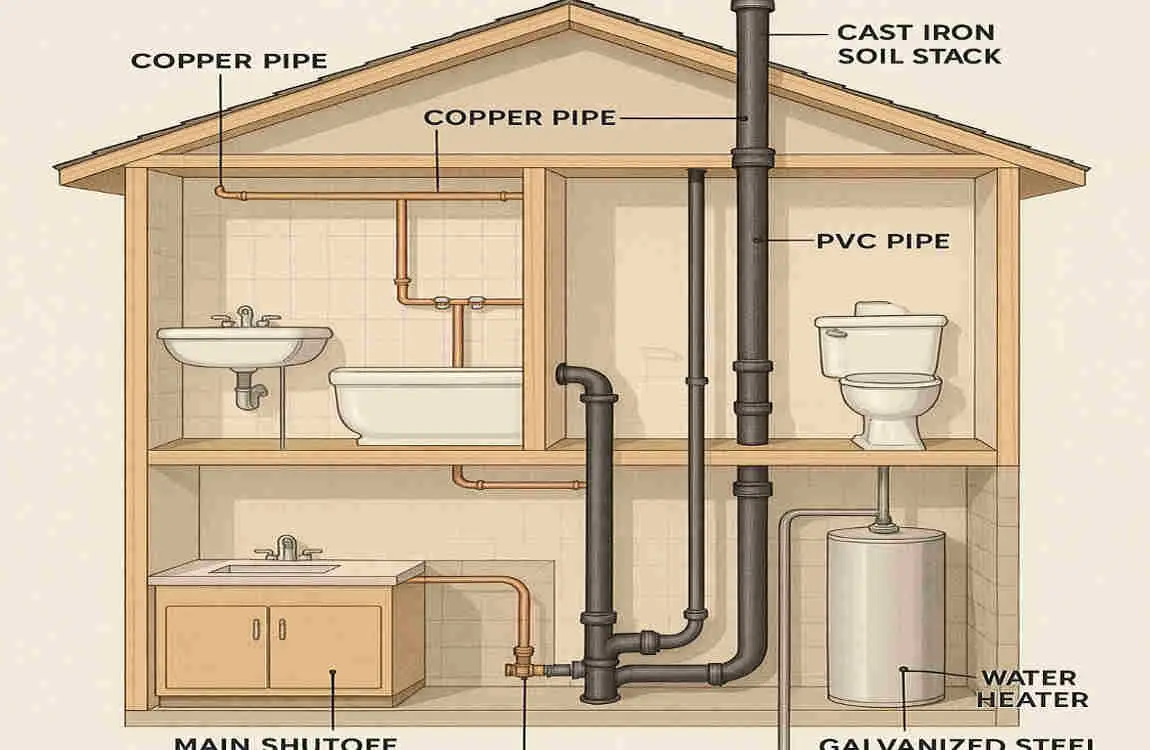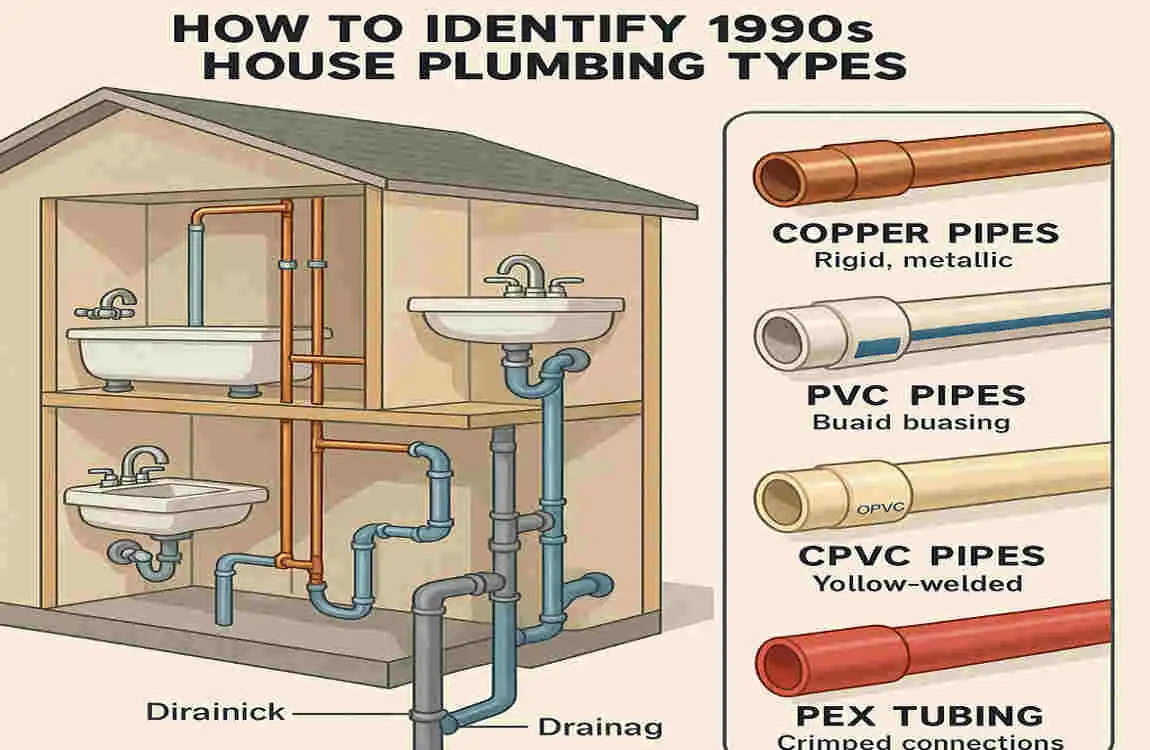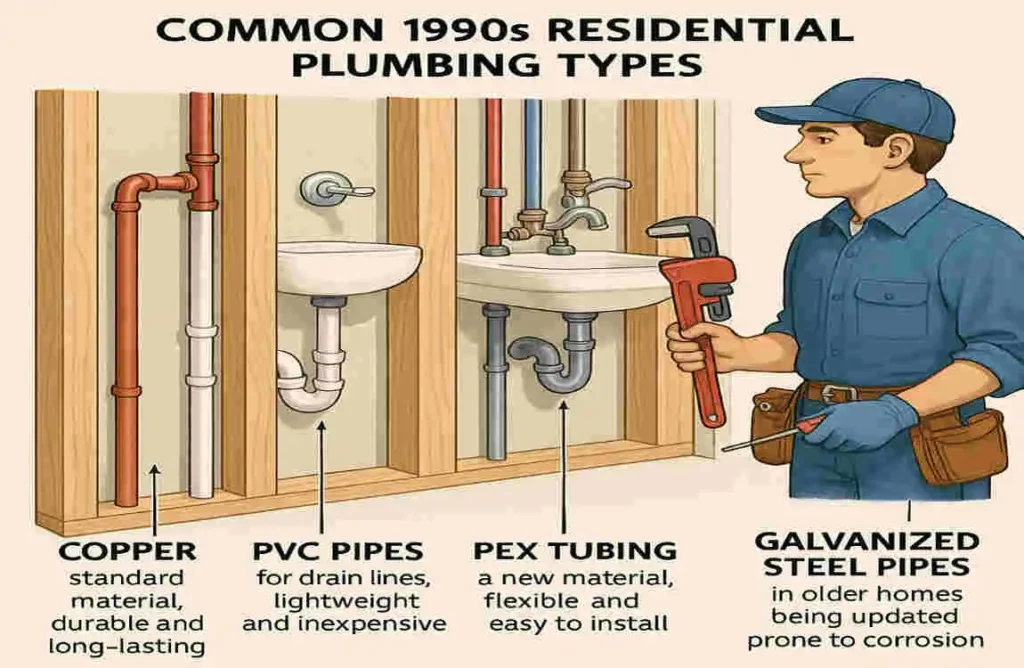Understanding the plumbing system in your home is crucial, especially if your house was built before 1990. Whether you’re a homeowner, a prospective buyer, or planning renovations, knowing what type of house plumbing was used in 1990 can save you time, money, and potential headaches. Plumbing systems from this era used a mix of materials, some of which have aged well, while others have proven problematic over time.
Why Understanding 1990s Plumbing Types Matters

The 1990s were a transitional period for plumbing materials. Some materials, such as copper, were still widely used, while newer options, including CPVC and polybutylene, were gaining popularity. However, not all these materials stood the test of time. For example, polybutylene pipes, once hailed as a revolutionary option, were later found to be prone to leaks and failures.
Knowing the type of plumbing in your home is essential for several reasons:
- Maintenance and Repairs: Different materials require different maintenance approaches. Identifying your pipes can help you address issues before they escalate.
- Insurance Implications: Some insurance companies may charge higher premiums or deny coverage for homes with certain types of plumbing, such as polybutylene.
- Renovation Planning: If you’re remodeling, knowing your plumbing type helps you decide whether to replace or upgrade your system.
- Health and Safety: Aging or deteriorating pipes can lead to water contamination or leaks, posing risks to your home and family.
Now that we understand why this is important, let’s examine the types of plumbing materials commonly used in the 1990s.
Overview of Plumbing in the 1990s
The 1990s saw a mix of traditional and modern plumbing materials. Here’s a quick overview of the most common types:
You may also read (how to locate leaks in home pool plumbing).
- Copper Pipes: A durable and long-lasting option, copper was still widely used in the 1990s, though its popularity was beginning to decline due to cost.
- CPVC Pipes (Chlorinated Polyvinyl Chloride): A plastic alternative to copper, CPVC has gained traction due to its affordability and ease of installation.
- Polybutylene (PB) Pipes: These gray or white plastic pipes were popular due to their low cost but were later found to be prone to leaks and failures.
- PVC (Polyvinyl Chloride) and ABS (Acrylonitrile Butadiene Styrene): Commonly used for drainage and vent systems.
- Cast Iron Pipes: Still used for drainage and sewer systems in some homes, especially older ones.
Each of these materials has unique characteristics, advantages, and drawbacks. Let’s explore them in detail.
Detailed Identification Guide for 1990s Plumbing Types

Copper Pipes
Copper pipes were a staple in plumbing for decades and were still widely used in the 1990s. Here’s how to identify them:
- Appearance: Copper pipes have a metallic, shiny appearance when new, resembling the color of a penny. Over time, they develop a greenish patina due to oxidation.
- Common Uses: Copper was primarily used for water supply lines and pipes.
- Advantages:
- Extremely durable and long-lasting.
- Resistant to heat and pressure.
- Does not leach harmful chemicals into water.
- Disadvantages:
- Expensive compared to plastic alternatives.
- It can corrode in areas with acidic water, leading to pinhole leaks.
How to Identify: Look for metallic pipes with a reddish-brown color. If the pipes are older, they may have greenish spots or streaks.
CPVC Pipes (Chlorinated Polyvinyl Chloride)
CPVC pipes became a popular alternative to copper in the 1990s due to their affordability and ease of installation.
- Appearance: CPVC pipes are typically cream-colored or light yellow, featuring a smooth plastic surface.
- Common Uses: These pipes were used for water supply lines inside homes.
- Advantages:
- Resistant to corrosion and chemical damage.
- Lightweight and easy to install.
- More affordable than copper.
- Disadvantages:
- It can become brittle over time, leading to cracks.
- Not suitable for outdoor use in extreme temperatures.
How to Identify: Look for light-colored plastic pipes with printed markings indicating they are CPVC.
Polybutylene (PB) Pipes
Polybutylene pipes were widely used in the 1990s but were later found to have significant issues.
- Appearance: PB pipes are available in gray, white, or blue and have a flexible, plastic-like feel.
- Common Uses: These pipes were used for water supply lines.
- Advantages:
- Inexpensive and easy to install.
- Flexible, making them suitable for tight spaces.
- Disadvantages:
- Prone to leaks and ruptures due to chemical reactions with chlorine in water.
- Subject to class-action lawsuits in the 1990s, leading to their market withdrawal.
How to Identify: Look for gray or white plastic pipes marked “PB2110.” If you spot these pipes, it’s crucial to inspect them for signs of deterioration, such as flaking or leaks.
PVC Pipes (Polyvinyl Chloride)
PVC pipes were commonly used for drainage and vent systems in the 1990s.
- Appearance: White plastic pipes with a smooth surface.
- Common Uses: Drainage, waste, and vent (DWV) systems.
- Advantages:
- Lightweight and easy to work with.
- Resistant to corrosion and chemical damage.
- Disadvantages:
- Can crack under stress or extreme temperatures.
- Not suitable for hot water supply.
How to Identify: Look for white plastic pipes with printed markings indicating they are PVC.
You may also read (12×12 bedroom house).
ABS Pipes (Acrylonitrile Butadiene Styrene)
ABS pipes were another common choice for drainage systems in the 1990s.
- Appearance: Black plastic pipes with a smooth surface.
- Common Uses: Drainage and vent systems, especially in mobile homes.
- Advantages:
- Durable and resistant to impact.
- Lightweight and easy to install.
- Disadvantages:
- Can warp or deform under high heat.
- Less commonly used today due to environmental concerns.
How to Identify: Look for black plastic pipes with printed markings indicating they are ABS.
Cast Iron Pipes
Cast iron pipes were still used in some homes for drainage and sewer systems in the 1990s.
- Appearance: Dark gray, heavy, and rigid metal pipes.
- Common Uses: Drainage and sewer systems.
- Advantages:
- Extremely durable and long-lasting.
- Excellent sound insulation.
- Disadvantages:
- Prone to rust and corrosion over time.
- Heavy and difficult to install or replace.
How to Identify: Look for heavy, dark gray pipes with a rough surface.
Why Knowing Your 1990s Plumbing Type Matters
Understanding your home’s plumbing system can have a significant impact on:
- Maintenance Costs: Some materials, such as copper, require minimal maintenance, while others, like PB, may necessitate frequent repairs or replacement.
- Insurance: Certain materials, such as PB pipes, may affect your insurance premiums or coverage.
- Health and Safety: Aging pipes can lead to water contamination or leaks, posing risks to your family.
- Renovations: Knowing your plumbing type helps you plan upgrades or replacements during remodeling projects.
How to Inspect and Identify Plumbing Pipes in Your Home
Here’s a simple step-by-step guide to inspecting your home’s plumbing:
- Gather Tools: You’ll need a flashlight, wrench, and camera.
- Check Key Areas: Inspect the basement, crawl spaces, under sinks, and exterior water lines.
- Look for Clues: Use the identification tips mentioned above to determine the type of pipes.
- Call a Professional: If you’re unsure or spot potential issues, consult a licensed plumber.
Common Issues with 1990s Plumbing Types and Solutions
Pipe TypeCommon IssuesSolutions
Copper Corrosion in acidic water areas: Install water treatment systems
CPVC is Brittle and prone to cracking. Replace damaged sections
Polybutylene (PB) Leaks and Ruptures. Full pipe replacement is recommended
PVC Cracking under stress: Replace damaged sections
Cast Iron Rust and corrosion, replace with modern materials
Modern Alternatives and Upgrades
If your home still has 1990s plumbing, consider upgrading to modern materials, such as PEX pipes. PEX is flexible, durable, and resistant to corrosion, making it a popular choice for new installations.
You may also read (dont let a leak ruin your home repair tips).

